Introduction
Do you have a product that’s taking off in your local space?
Have you ever thought about taking your ecommerce shop worldwide?
To expand into international markets and increase your sales?
Unfortunately, doing this is one of the toughest tasks when it comes to scaling an ecommerce business.
Scaling a business for international sales can grow your business fast.
You are opening up your market to vast populations that could be interested.
But it’s not as simple as shipping your products overseas or fulfilling orders for customers in a different country.
You need a plan in place that allows you to meet the potential demand of scaling your product this fast.
And you need marketing tactics ready to go to boost sales in a country that doesn’t yet know your product.
On top of that, you need to make sure that you protect your intellectual property rights from copycats.
It’s a long, tough road to scaling your sales in different counties. But it’s surely possible.
That’s exactly what Gaston of Hickies did to grow his company to reach over 50 countries worldwide.
Thankfully, he left a trail of breadcrumbs for us to follow.
Here’s how Gaston scaled Hickies worldwide and how you can bring your product to 50 different countries.
How Hickies scaled their company to other countries

Hickies is a revolutionary shoelace product company that Gaston Frydlewski started in 2011 in Brooklyn, New York.
Gaston invented the product to make shoes easier to tie and increase their comfort and usability levels.
As a former kid who never enjoyed tying his shoes, Gaston built the company from his innovative ideas.
He noticed that there was a global opportunity in this space that wasn’t being tapped into yet.
Hickies attach to any shoes that have shoelaces. They allow you to modify the fit so that you never have to retie laces again.
Once you attach them, your shoes will always hold the same fit, and you can comfortably slip them on and off with no effort.
Coming from an investment-banking background, he had seen plenty of challenges that people were having with typical shoelaces.
He noticed that parents were frustrated with their kids’ shoes, that kids didn’t want to tie them, or that people were opting for shoes without laces.
Shoes were evolving at light speed, while shoelaces have remained the same for decades.
He quickly realized that there was an explosive market for this product just waiting to be jumped on.
Now, he sells his products in 50 countries and his main products fit with any type of shoe:
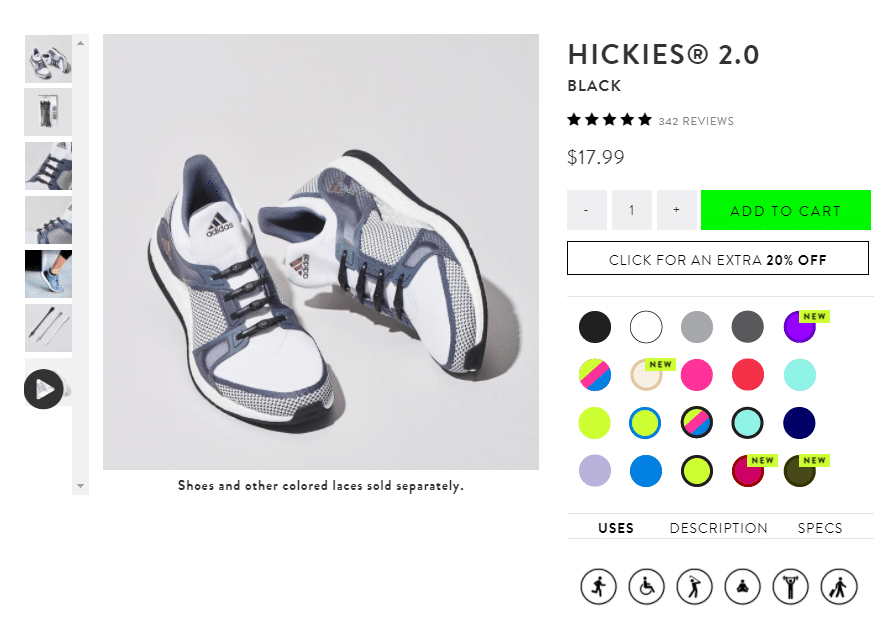


He had a burning desire to produce his product, and he started from the ground up to make it happen.
After more than a year in production and development, he knew that his product was ready for the market.
But he also lacked money. And he needed a patent for his product to prevent any company from copying the design and undercutting his margins.
In the end, he secured over 70 patents worldwide without the help of a lawyer.
But with all these patents and a great piece of technology, he needed a way to scale the product and get more customers.
He started by launching a Kickstarter campaign that got global attention.



The company did multiple campaigns that raised hundreds of thousands of dollars to bring the idea to new countries.
They immediately began receiving inquiries from people in Japan and various other Asian countries.
With the protection of his new patents, he was ready to expand his sales into the global market.
He started selling his products on the top international marketplaces and shipping his products worldwide.
With a great marketing plan and months of planning, he is successfully selling his products in 50 countries around the world.
Here’s how you can scale your business internationally by following the advice of Gaston at Hickies.
5 steps to scaling your business internationally
Step 1. Research markets where your product is popular.
Before taking your product to new heights by tapping into international markets, you need to conduct market research.
It’s just like researching to see if your product will be successful before diving into a new business. You need to know if there will be demand for your product in other countries.
If there isn’t, you can’t afford to waste time and money on it.
For example, with the first Kickstarter campaign that Gaston ran for Hickies, he found a huge interaction and support base in Japan.
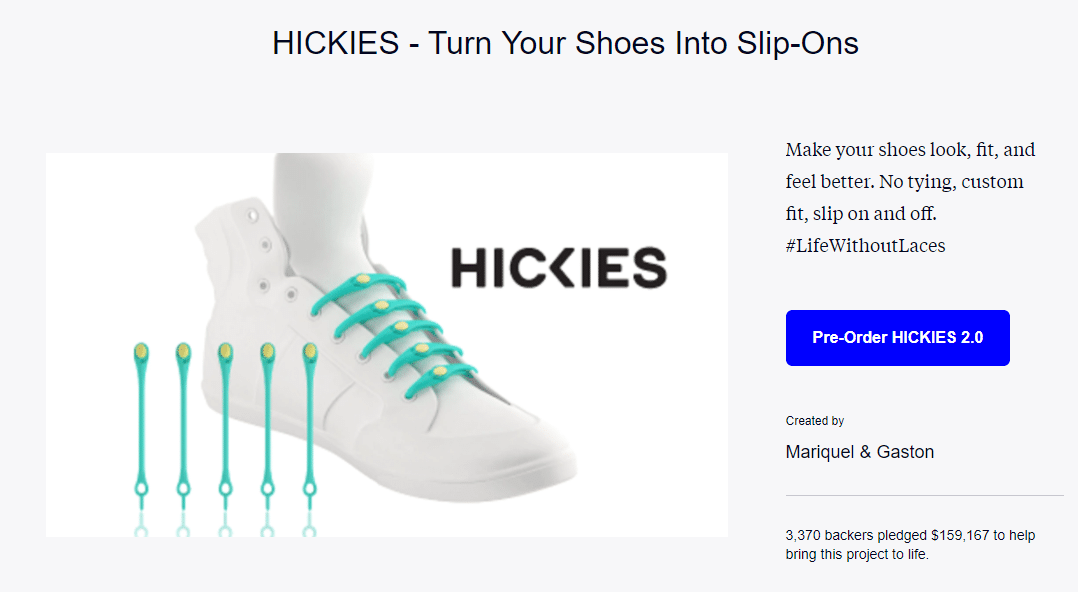


Research is key to knowing whether or not your product is going to find success.
You have to tap into each market to see which products sell well and which don’t.
One of the best ways to scout product searches in different companies is by using Google Trends.
With Google Trends, you can explore trending topics, products, and searches by country. These options allow you to see the popular ecommerce searches that are taking place in a specific region.
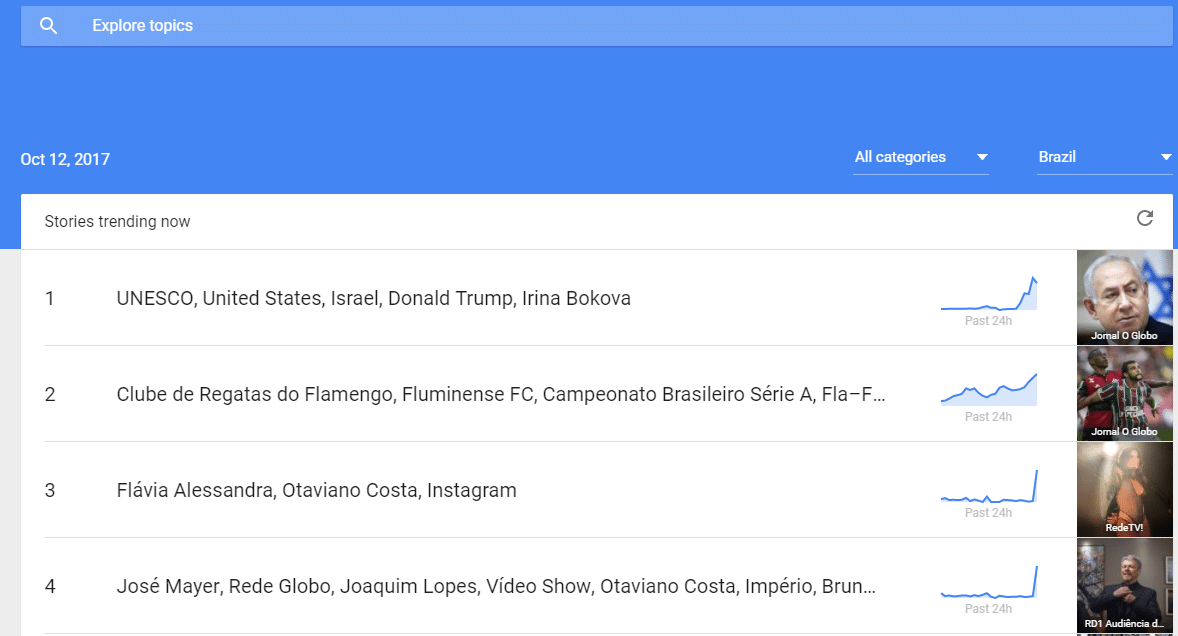


Open up Google Trends and start by selecting the country you want to explore trending data in:



Once you’ve picked a country, head to the search bar above and type in popular keywords and search queries in your industry.
For example, you could search for something like “basketball shoes” or “makeup products,” depending on what you sell.
Here’s an example search using the filter for Japan results:
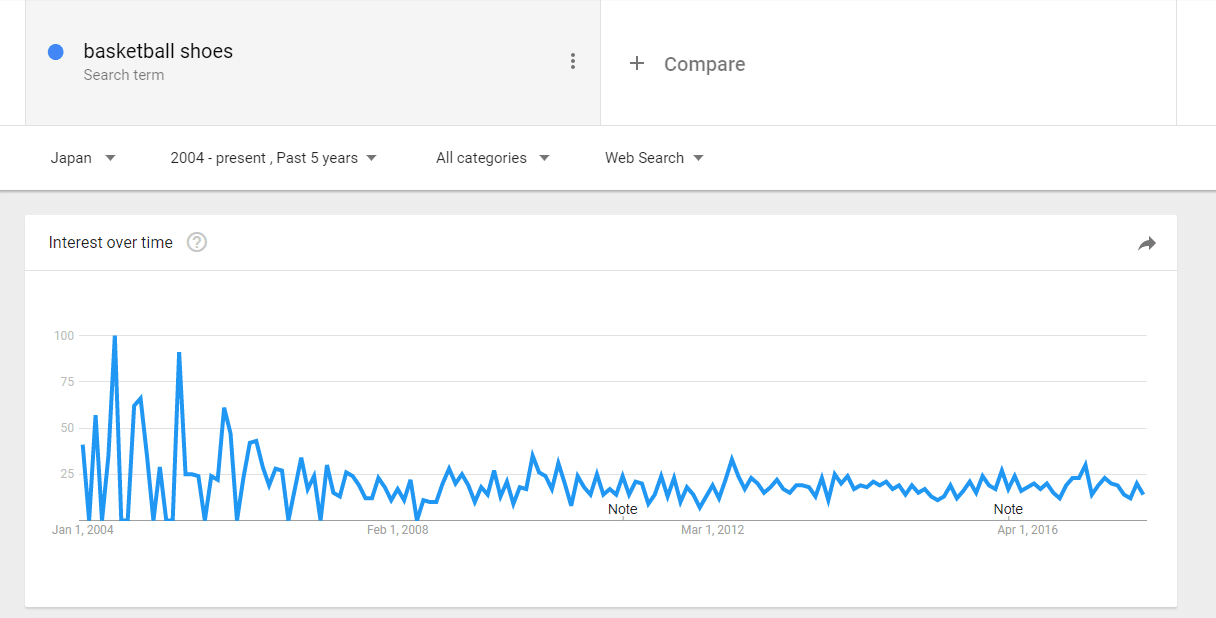


If you notice mediocre results, you can start using various filters on the Google Trends program to narrow down results.
Click on “Web Search” and change the results to Google Shopping to see ecommerce-specific results:
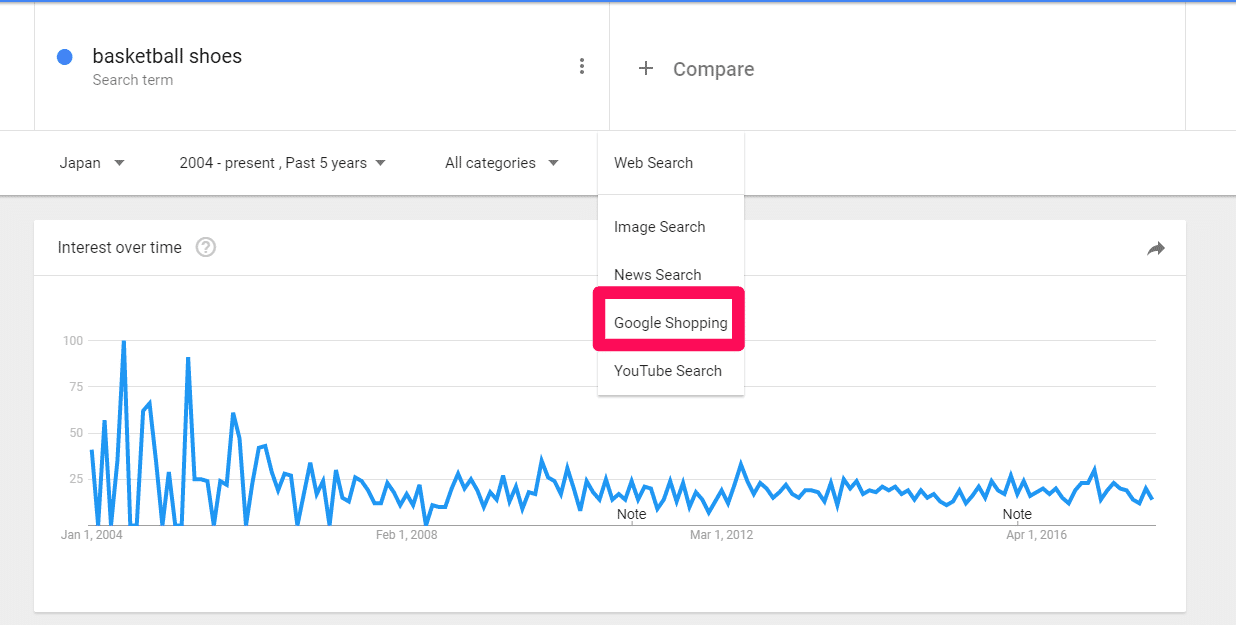


Now you should start to see very different results that can give you hints of seasonality and shopping habits of your specified country:
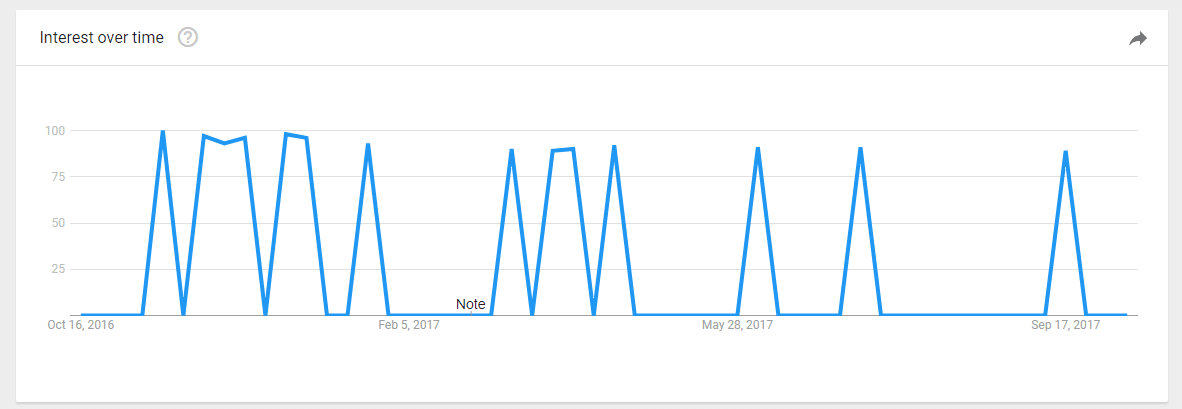


Repeat this process for different countries of interest.
For example, if you switch the search results from Japan to India, you can see information sorted even further by subregions:
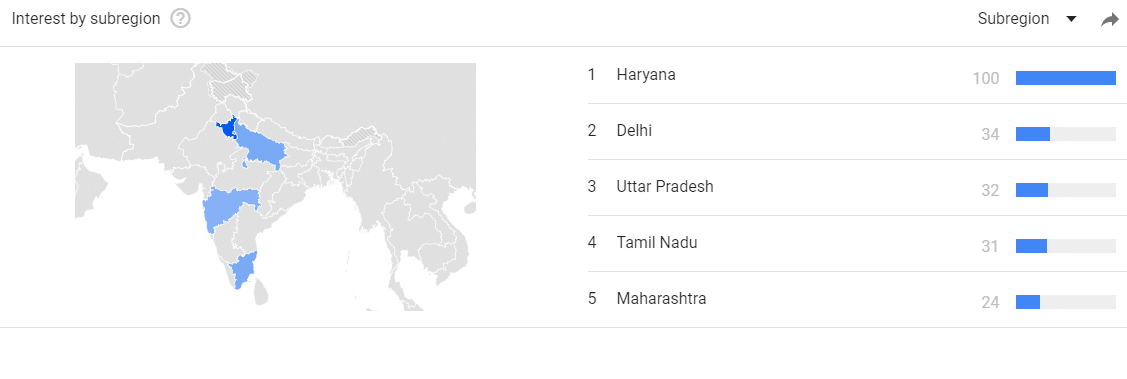


If you have trouble locating countries that are showing interest in these products, head to the top of your search and select “Worldwide” as your filter:



By choosing the worldwide option, Google Trends can now give you a large map showing you the top areas where interest is being shown for that search term.
On top of that, having the Google Shopping filter enabled will help you see if these countries are purchasing at high rates.
Here’s what the search data shows:
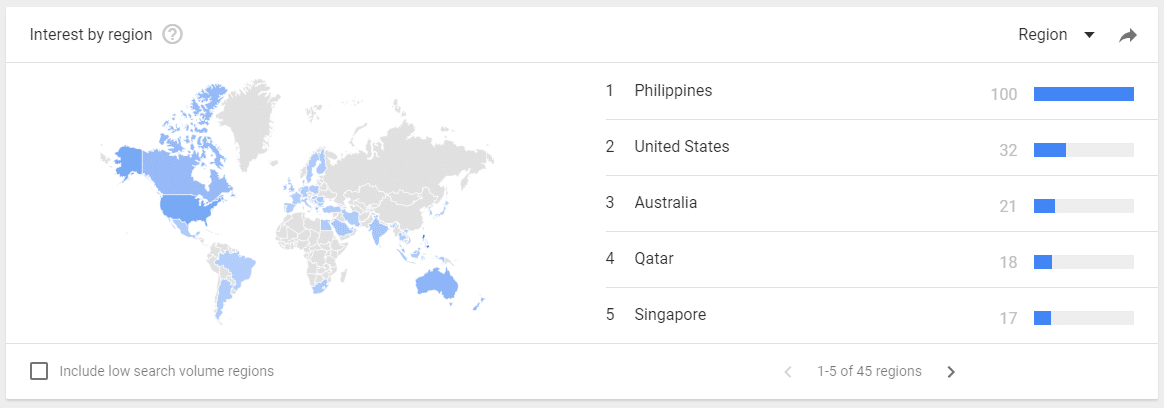


The Philippines has a high level of search interest and shopping data when it comes to basketball shoes.
You’d have a huge opportunity to sell your shoes in the Philippines, even more than in America.
This is a great resource for developing a plan of action and seeing which target markets are likely to buy from you.
Instead of flying blind, conduct this research on your products to make sure that countries are worth the investment.
Develop a solid plan to enter these markets only after you’ve shown that they will buy from you.
Once you do, it’s time to launch a Kickstarter campaign to raise money and gain even more information on market research.
Step 2. Start a Kickstarter campaign to raise funds.
When it comes to crowdfunding platforms, Kickstarter is one of the best options available to entrepreneurs.
It allows entrepreneurs to post products and have the large user base “fund” the project by giving money in exchange for a pre-order.
Gaston of Hickies said that Kickstarter was a huge part of the success of his business. It even helped him find out where to drive sales in international markets.
According to Kickstarter, they’ve raised billions of dollars in pledged funds by users on the site to over 100,000 projects:



The site has contributed to over 13 million backers, 4 million repeat backers, and over 41 million pledges.
It’s safe to say that Kickstarter is great for getting your business off the ground.
Instead of grinding away at search engine optimization or spending thousands of dollars on digital advertising and PPC, you can tap into a network of buyers that already exists.
To start running a Kickstarter campaign, head to their homepage and create a free account:
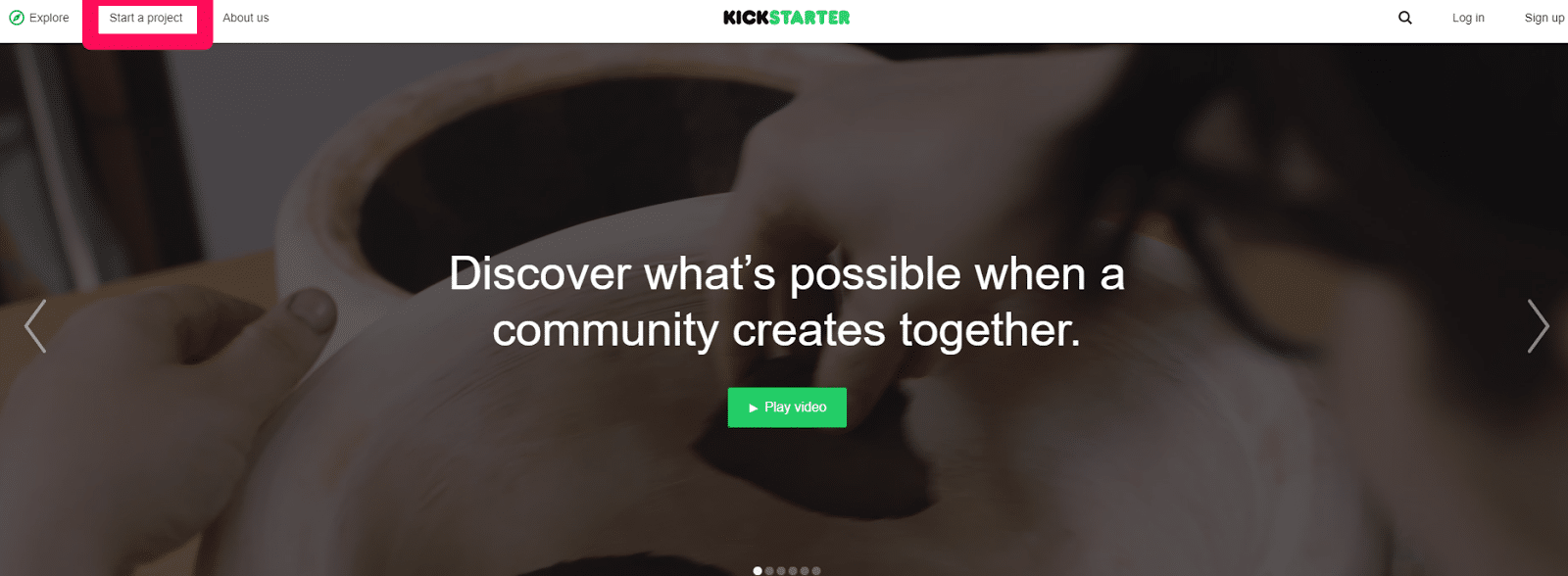


Click “Start a project” to begin selecting the categories for your product to show up in:



Next, give your project a title and choose your current country of residence:
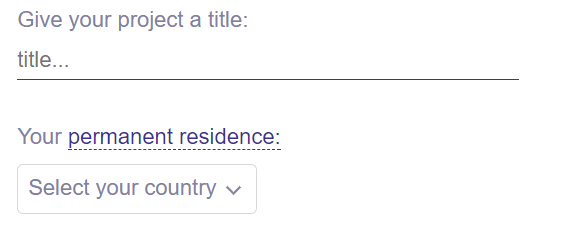


Next, link your email account and sign up for a Kickstarter login.
From your dashboard, you can start to edit your campaign image, goals, and more:
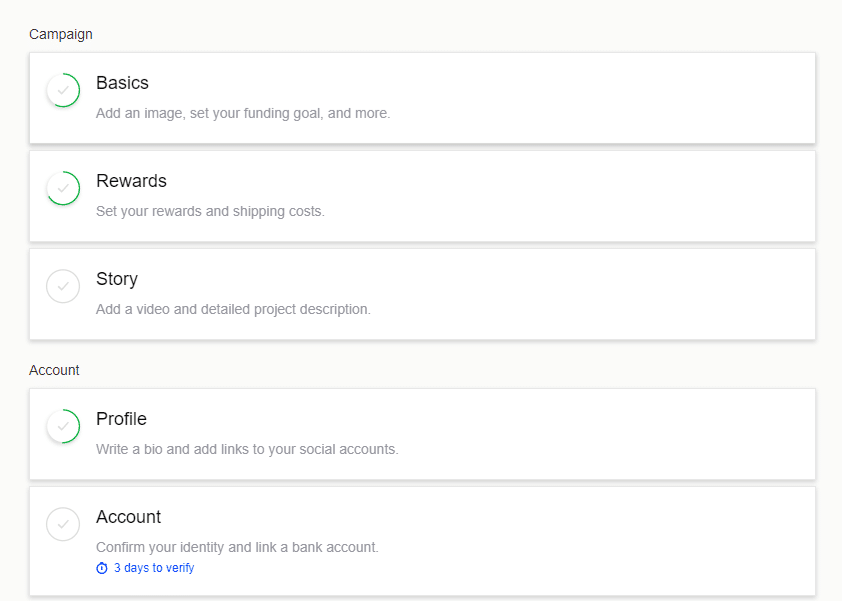


You can customize your rewards and shipping costs too.
Start by giving your product detailed images to draw tons of interest.
To start building out your profile, click “Basics,” and fill out the product information:
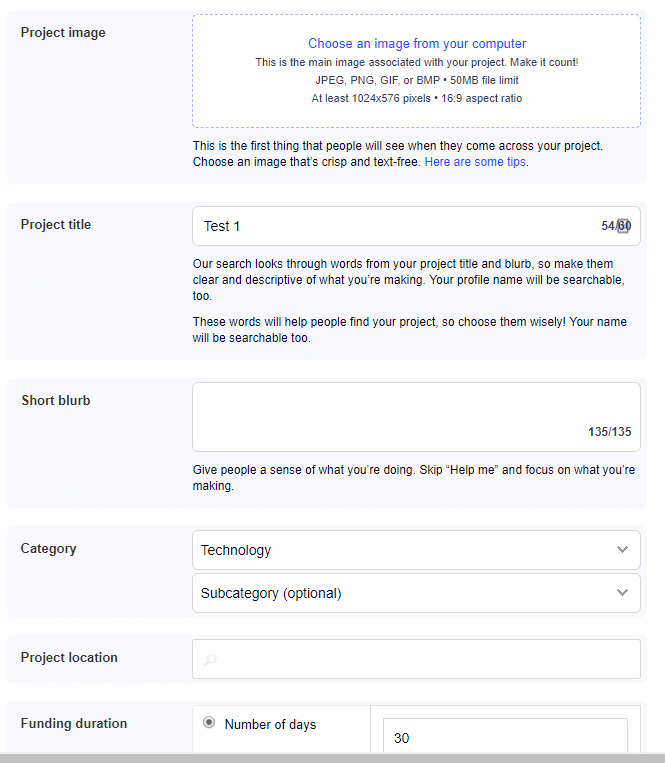


Be sure to upload high-quality product shots and give a description that is compelling and easy to understand.
Kickstarter can be the difference that your business needs to break through to international markets.
And it’s not just great for raising funds. It’s also a powerhouse of data.
To make sure that your product can sell in international markets instantly via Kickstarter, you need to enable a few settings for shipping.
In your dashboard, navigate to the “Rewards” section where you can edit the shipping features:
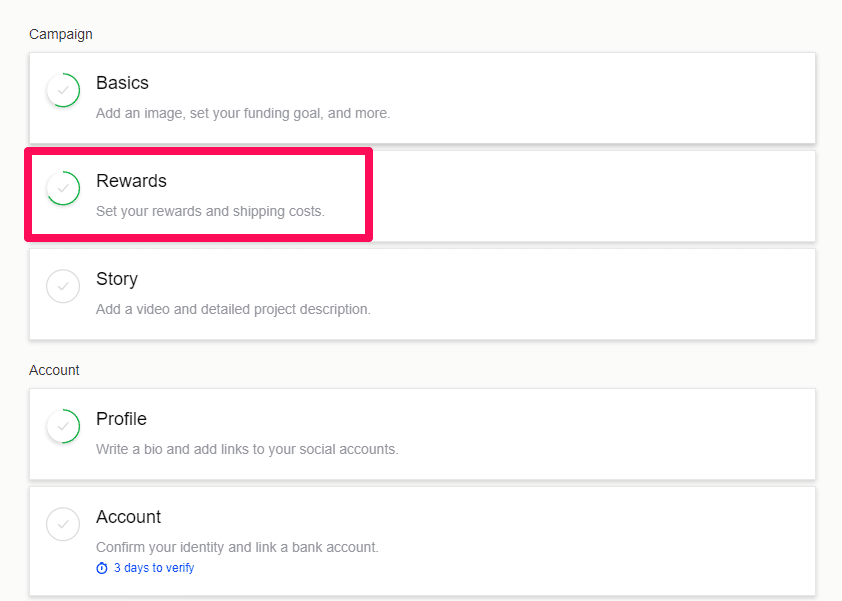


From here, be sure to select “Ships anywhere in the world” under “Shipping details”:
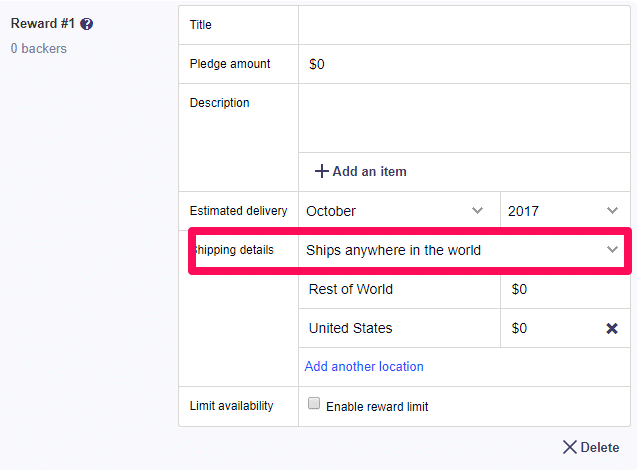


This option will allow you to instantly sell products around the world while simultaneously testing those markets without risk.
Once you’ve successfully run a Kickstarter campaign, the platform provides you with some of the most useful data of all:
Community data.
This data shows you where people supported you from. Meaning you can see which countries and cities were most popular when backing your product.
This information gives you incredible insight into where you can market and target your product to scale worldwide.
To find this data, head to your Kickstarter campaign page and click on the “Community” tab:
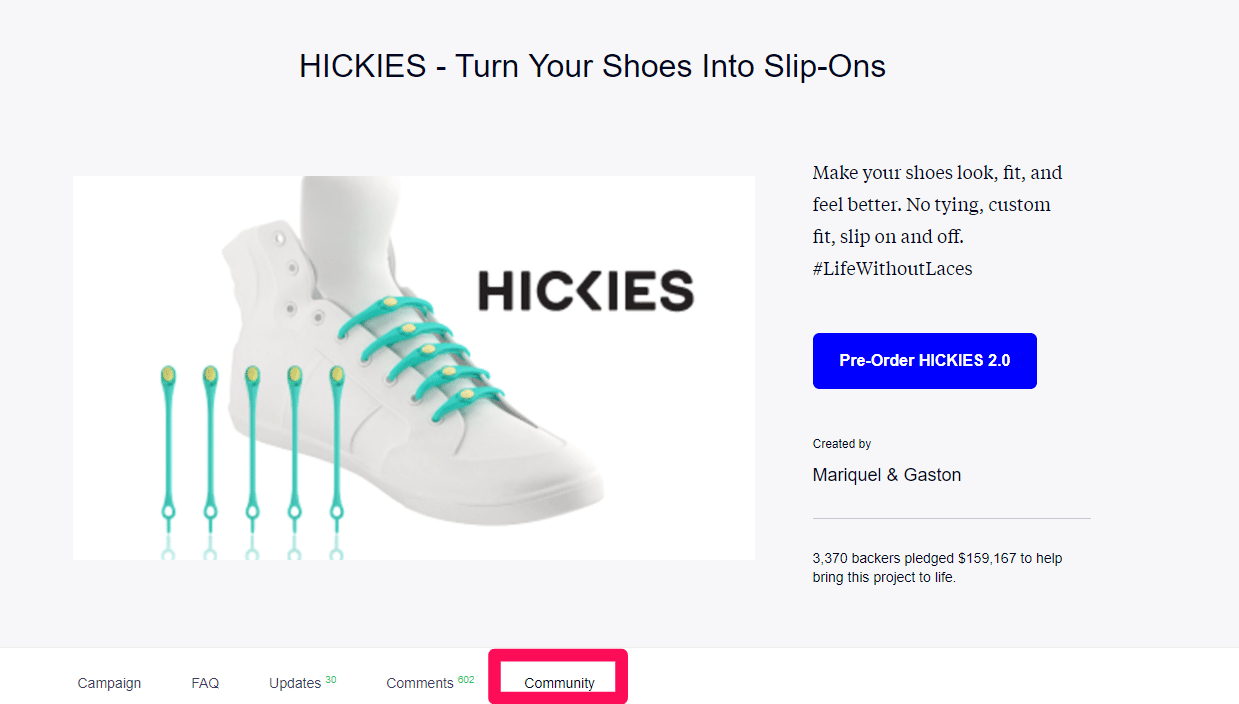


From here you have access to all of the top cities and countries that backed your campaign:
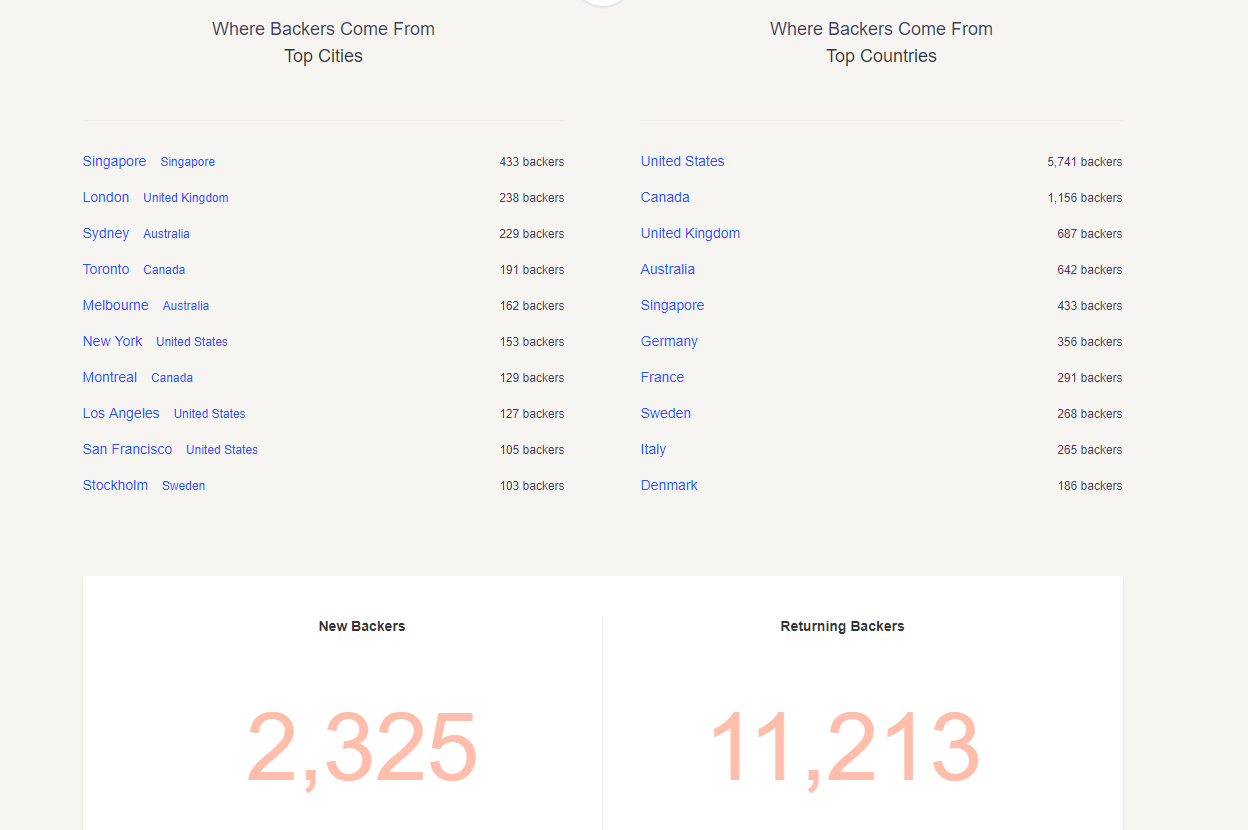


This data should inform your marketing and sales decisions when it comes to tapping into new markets.
Step 3. Protect your product with patents.
Running a Kickstarter campaign is a great step in bringing your product to international markets.
You can successfully test the product in different regions and collect valuable data without taking on much risk.
But once you’ve done this, you need to start filing for patents in international countries.
Gaston said that without these, he wouldn’t have been able to survive the competition from knock-offs.
He also noted that typical patent lawyers can cost up to $20,000, which is a price that almost no small business can afford to pay.
Luckily, there are a few workarounds and ways to get the job done on your own.
But keep in mind that this isn’t an easy process. It won’t happen overnight, but the impact can be life-saving.
Because of his patent, Gaston currently collects damages from companies that tried to rip off his product.
But without one, any business could have stolen his idea.
To get started, check out this link that will take you to a patent FAQ to tell you if your product might qualify for one.
According to them, anything on the following list can qualify:
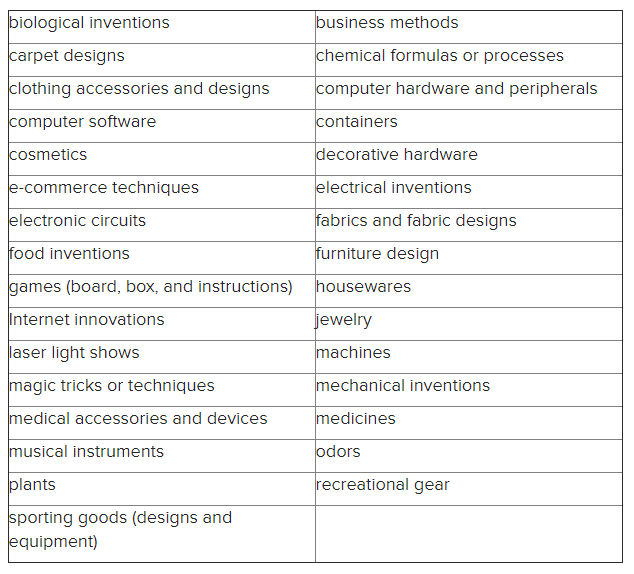


Once you’ve determined that you can get a patent for your products, head to an online patent searching site to see if any existing patents might block you from getting one:



Once you’ve ensured that there are no patents for your product or one that might get you in trouble with copyright infringement, it’s time to fill out some paperwork.
To get started with paperwork for your patent, head to this guide and follow the instructions at the bottom of the page.
Getting a patent is one of the best ways to protect your international property.
You can’t risk letting a business steal or copy your ideas and undercut your costs.
Step 4. Sell on international marketplaces.
One of the easiest and fastest ways to scale your ecommerce business to 50 countries worldwide is by using Amazon.
When it comes to buying and spending power, Amazon is a powerhouse.
Currently, there are an estimated 80+ million Amazon Prime members in the United States alone, not including people who buy on Amazon without a prime subscription account:
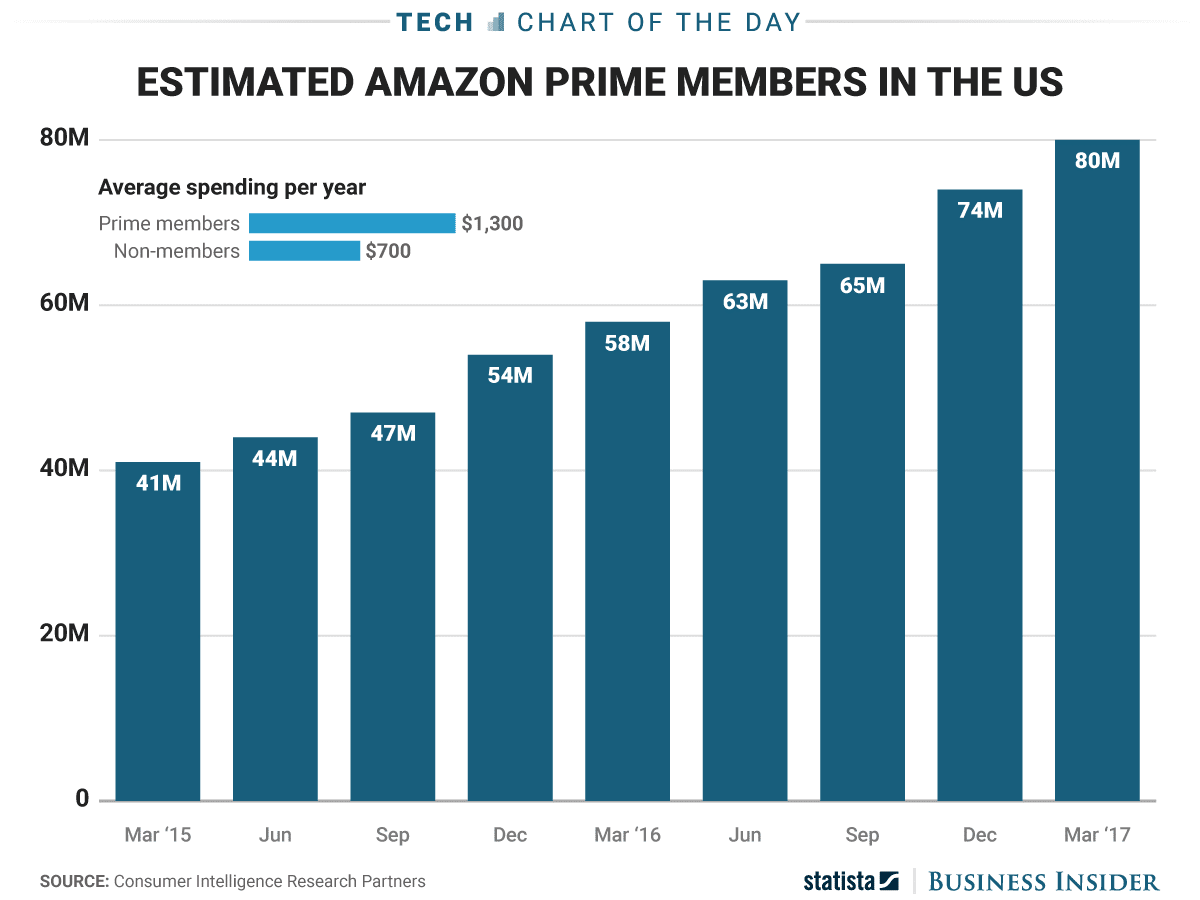


Amazon is continually growing each and every year. They dominate the online market when it comes to shopping.
Amazon’s revenue in 2016 alone was at 136 billion dollars, surpassing Google and coming close to Apple:
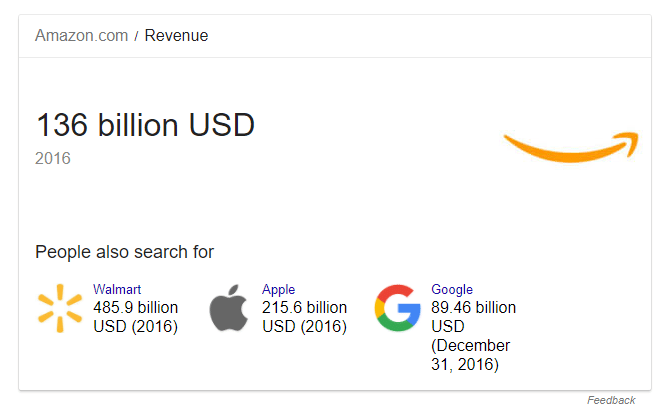


Currently, with Amazon Global, you can ship to over 100 countries across the globe using their platform:
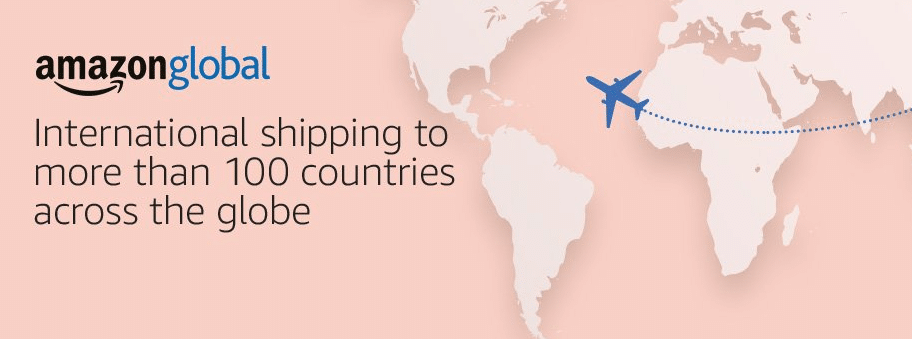


Here are some of the countries and locations that Amazon ships to currently:
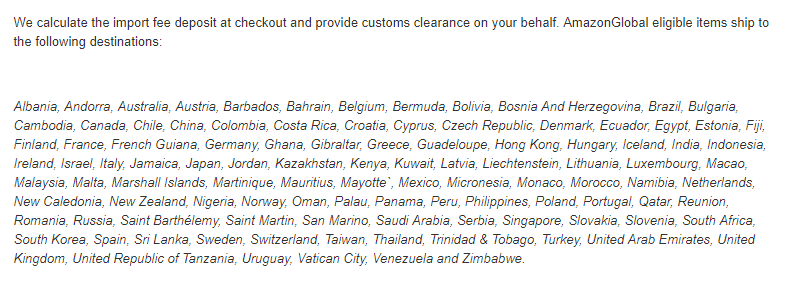


Using Amazon’s platform for scaling your business is one of the fastest ways to penetrate international markets.
They handle the import fees and customs-based clearance on your behalf, virtually eliminating all hassle, risk and time you could waste on your end.
With Amazon Global, you can tap into 11 marketplaces, 120+ fulfillment centers, and 180+ countries with loyal Amazon customers:
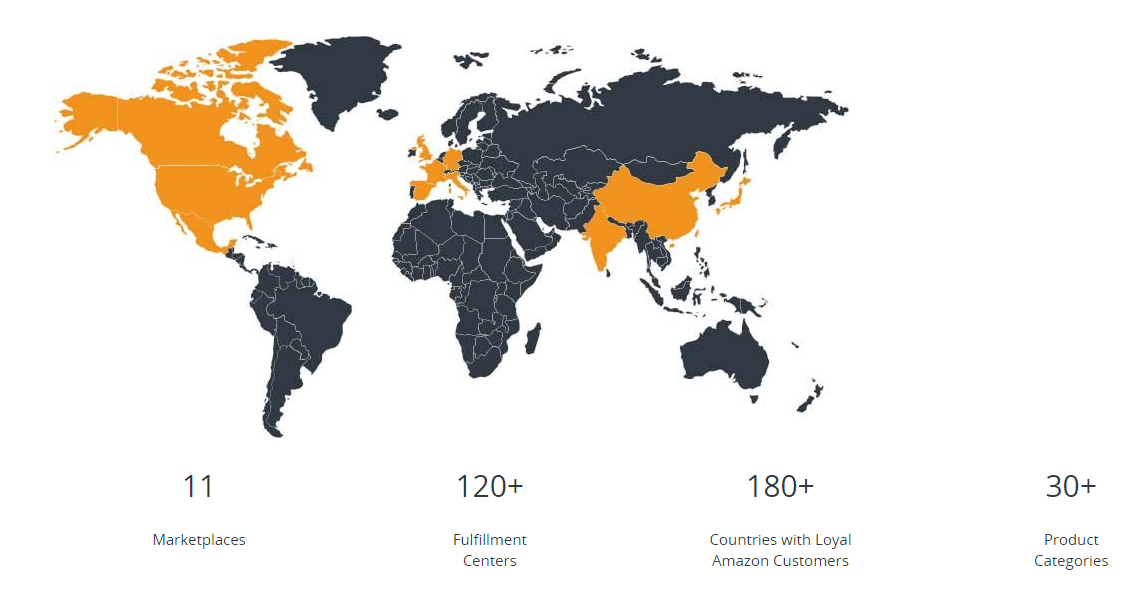


Amazon is the place to be when it comes to online marketplaces.
If you can’t get traction on your own business or don’t have the time and money to grow your international marketing brand, you need to use a third party marketplace like Amazon.
You can get started in just a few easy steps, too:
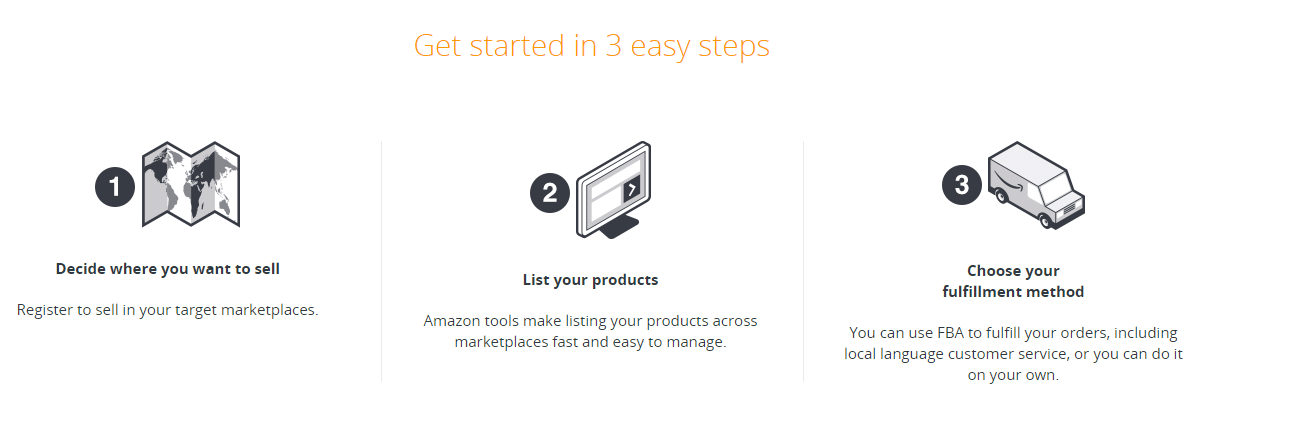


First off, you need to decide where to sell. You should have already figured this out in steps one and two!
Next, you need to list your products on Amazon, making them findable in multiple countries and marketplaces.
Lastly, you can use Amazon’s fulfillment for ease of use, or implement your own.
To get started on Amazon Global today, head to their site and click “Expand Internationally” to start selling your products.



From here you can set up your Amazon Global selling account. Be sure to have your business name and address, mobile or work phone number, tax information, and bank account info ready to go:



Enter your legal name to continue:
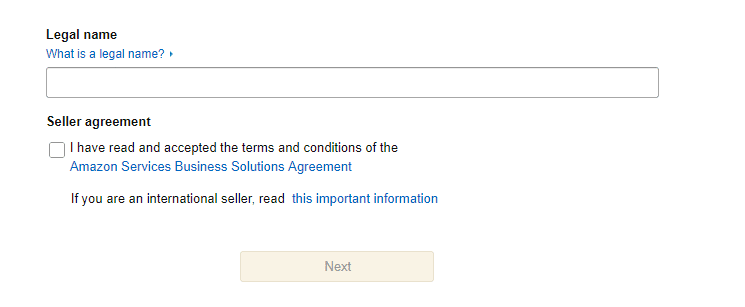


From here, input your personal information, billing and deposit details, and tax information. And then start entering your products on the marketplace almost instantly:



Follow the step-by-step instructions that Amazon provides, and you’ll be on your way to selling globally.
Amazon is a great marketplace for small ecommerce shops that are looking to go global.
When money is tight, and marketing isn’t driving traffic, you need a marketplace that can sustain its own traffic.
Amazon is one of the best sites for selling products online.
The buying power and customer loyalty are unparalleled in the ecommerce world.
Give it a shot today to quickly expand your sales into new countries and take your business to new heights.
If you don’t like Amazon, you can sell your products on Alibaba, too.
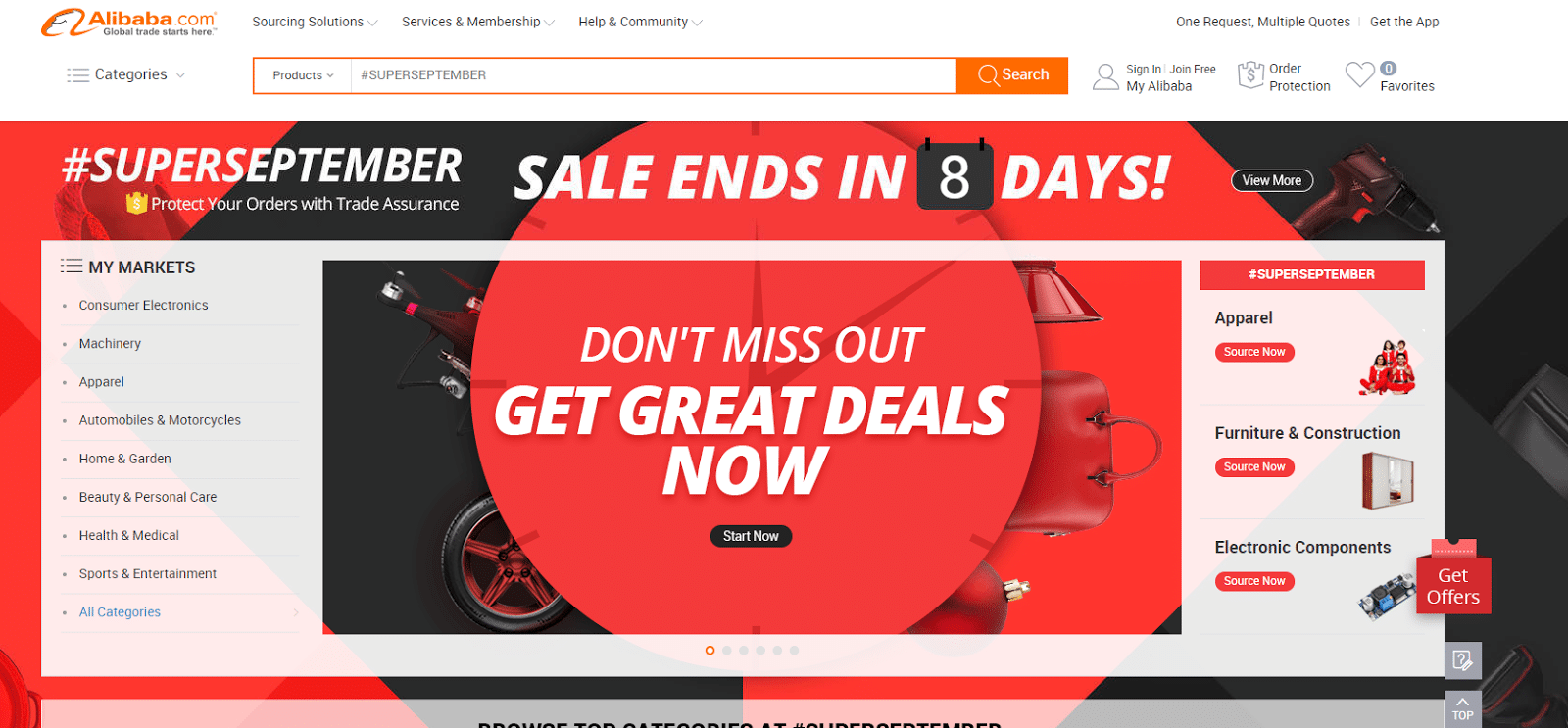


Alibaba is a global marketplace that’s free to join and allows you to quickly start selling your products to hundreds of countries.
And according to Statista, Alibaba boasts that nearly half a billion active online shoppers are using their platform:
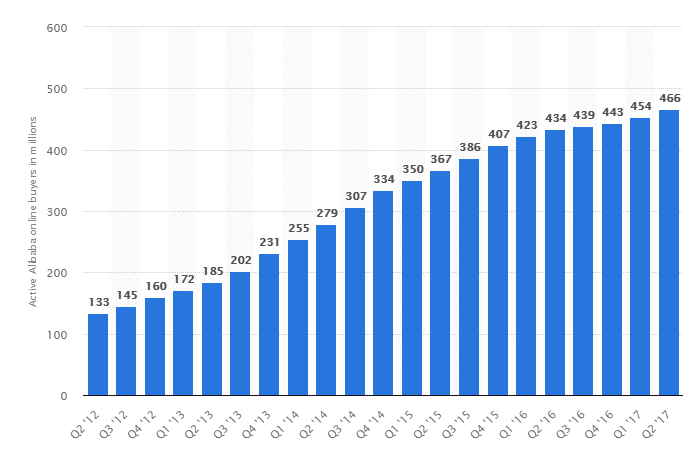


On top of their continued success, they went public with an IPO in 2014 and became the largest, record-setting IPO in history:
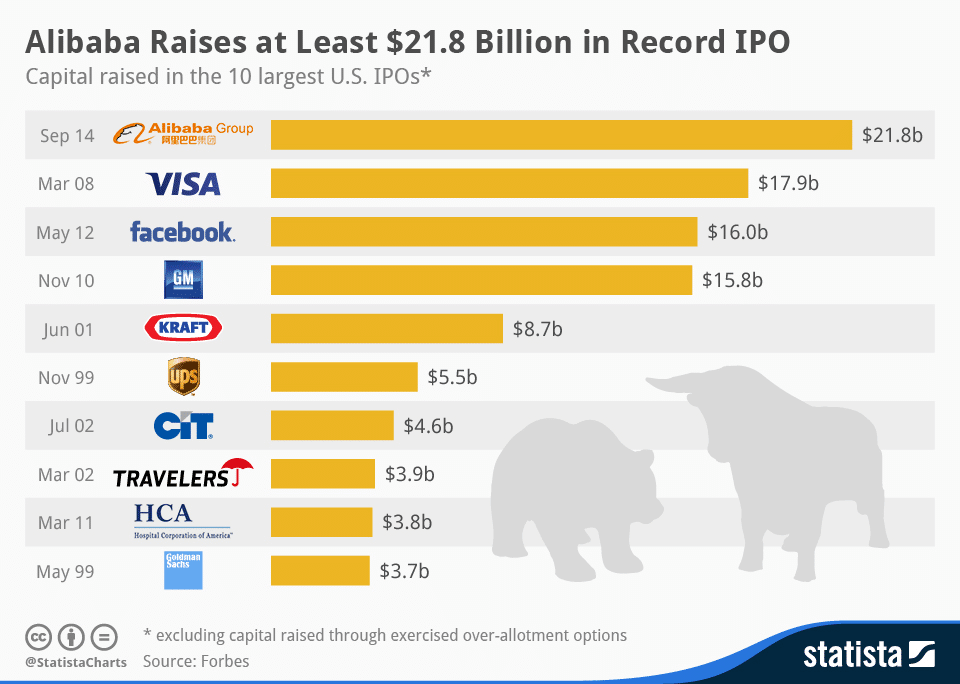


Alibaba has continued to drive tons of revenue on their site with millions upon millions of active buyers.
The spending power that Alibaba has is huge and comparable to Amazon, making it a great place to start selling your products in new countries and target markets.
To get started on Alibaba, head to their selling page and apply for a plan:
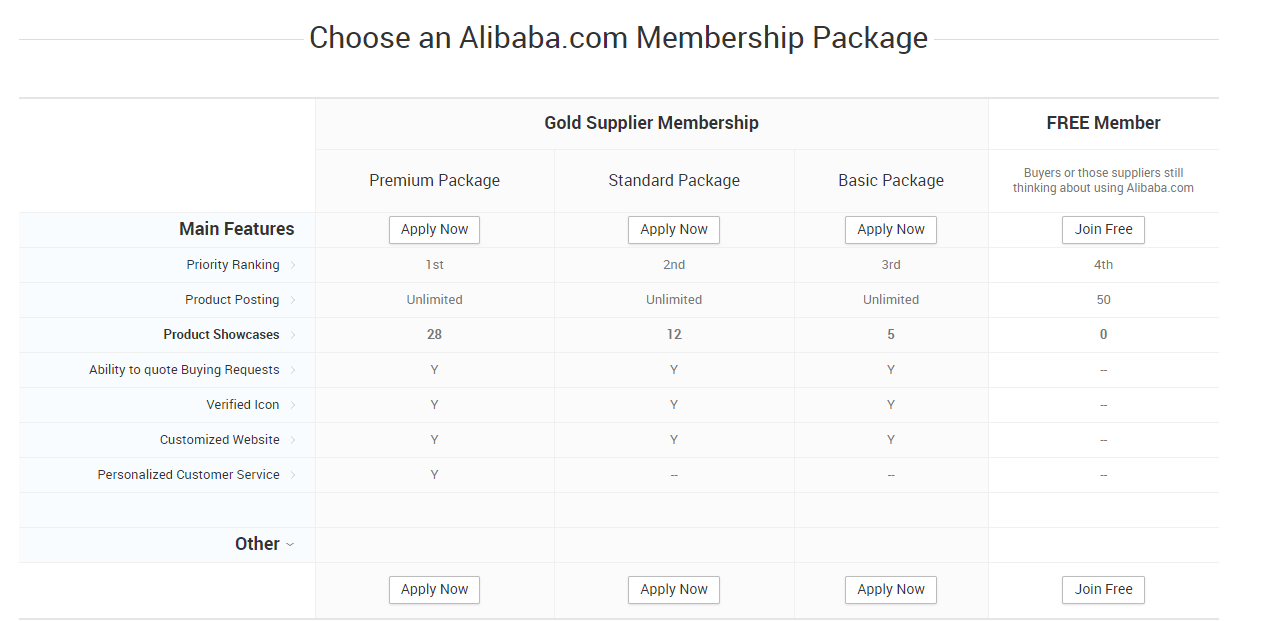


Once they accept your membership (or you join via a free account), you can list and sell your products fast.
Alibaba is also home to tons of great resources when it comes to global ecommerce:
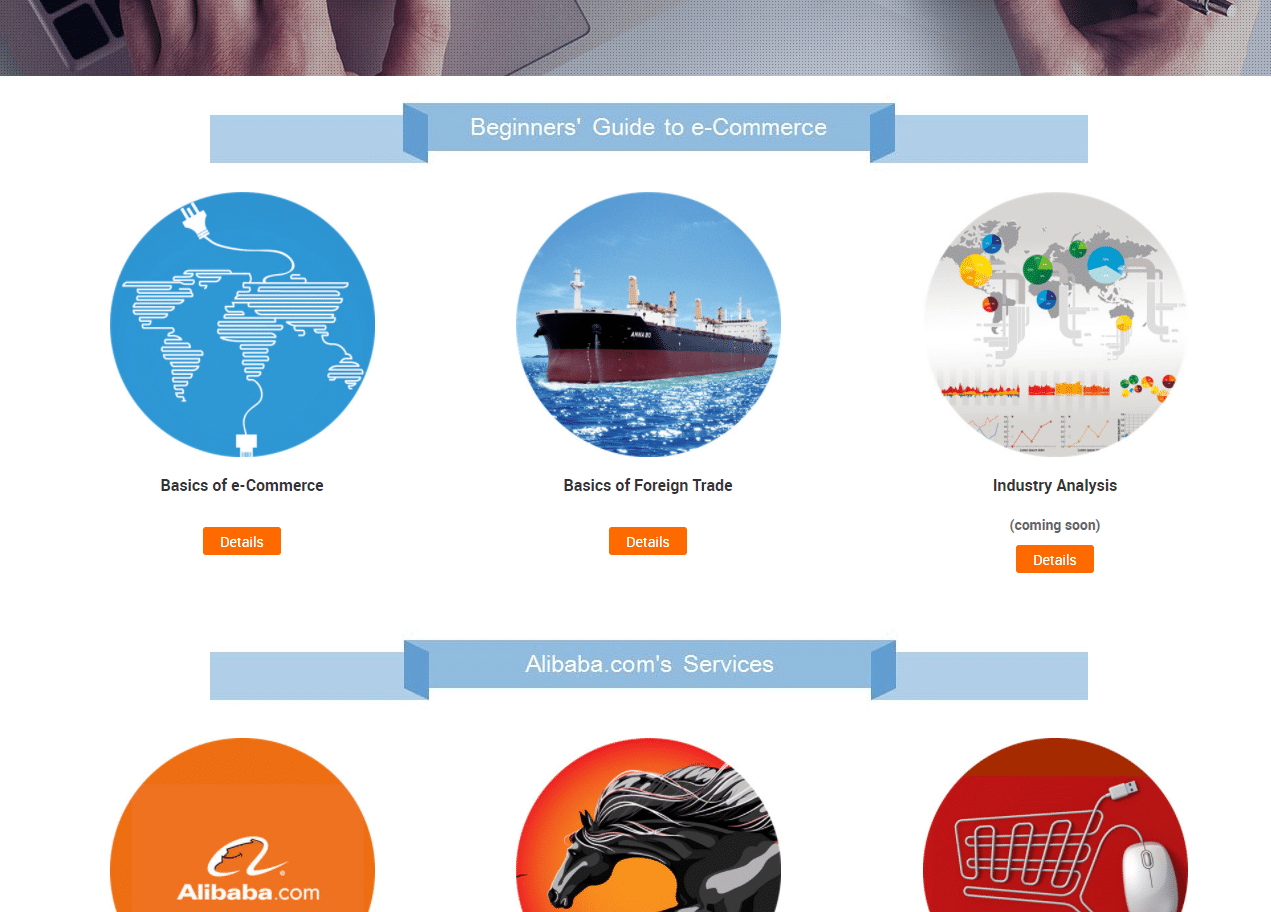


They have lots of detailed guides that can help you take advantage of the platform for the least money and time possible.
Alibaba is a great source of knowledge to get your company featured in international markets.
Get your products into 50 new countries by taking advantage of third-party marketplaces.
They have already done the legwork for you when it comes to marketing and getting you in front of eligible buyers.
Step 5. Ship your products internationally.
If selling your products on a third-party website/marketplace isn’t your goal or desire, you can start selling products internationally on your own.
If you are ready to branch out into new countries, you need to set up shipping options that allow you to deliver products anywhere in the world.
One of the easiest and fastest ways to start delivering your products to new countries is by using a third-party shipping service.
For example, services like FedEx Cross Border and My American Shipper are great platforms to try out.
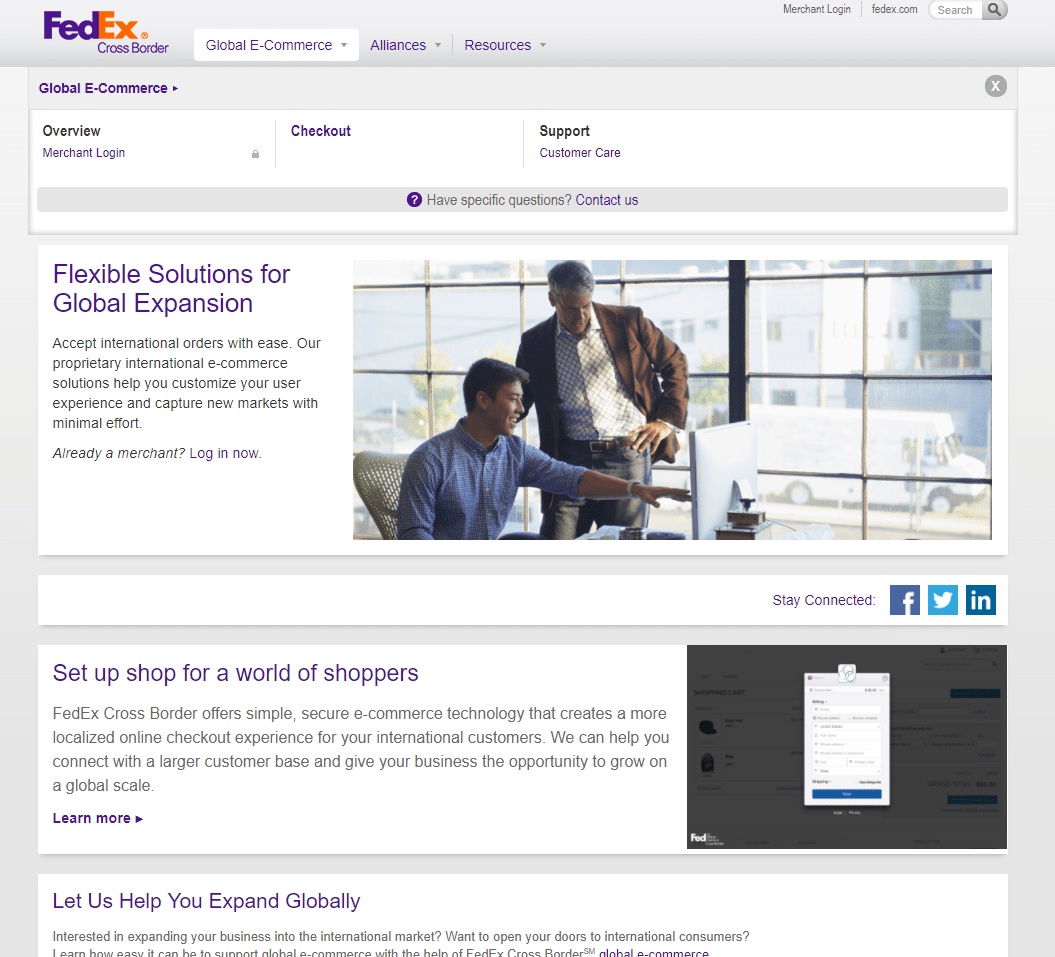


FedEx has growing solutions for global ecommerce shipping that can help your business expand fast.
Merchants that use the FedEx international ecommerce platform can get tons of great benefits:



FedEx provides diverse software solutions, increased speed and conversions, security measures, and easy returns.
On top of that, their platform easily integrates with the top ecommerce platforms like Shopify and Magento.
Once you sign up for an account, you can download the Tracking and Delivery Update plugin from AfterShip:
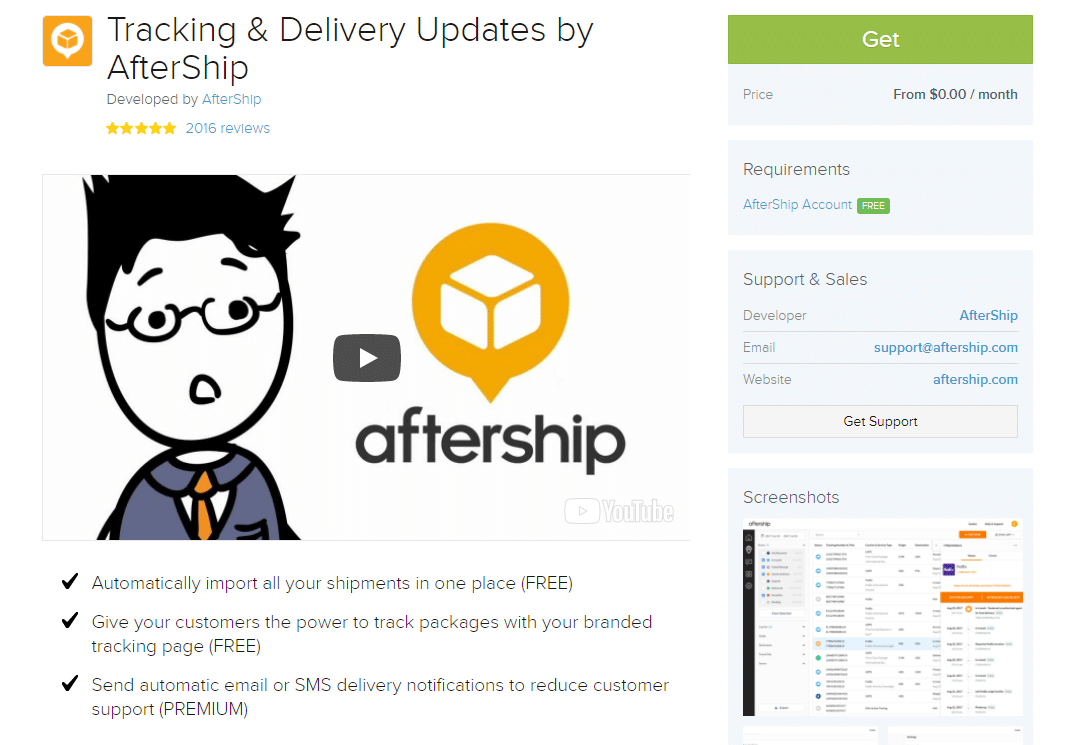


This tool allows you to track all of your shipments with trusted carriers like UPS, FedEx, and more in 380 countries around the world.
You can easily manage all of your tracking data and each delivery from their dashboard:
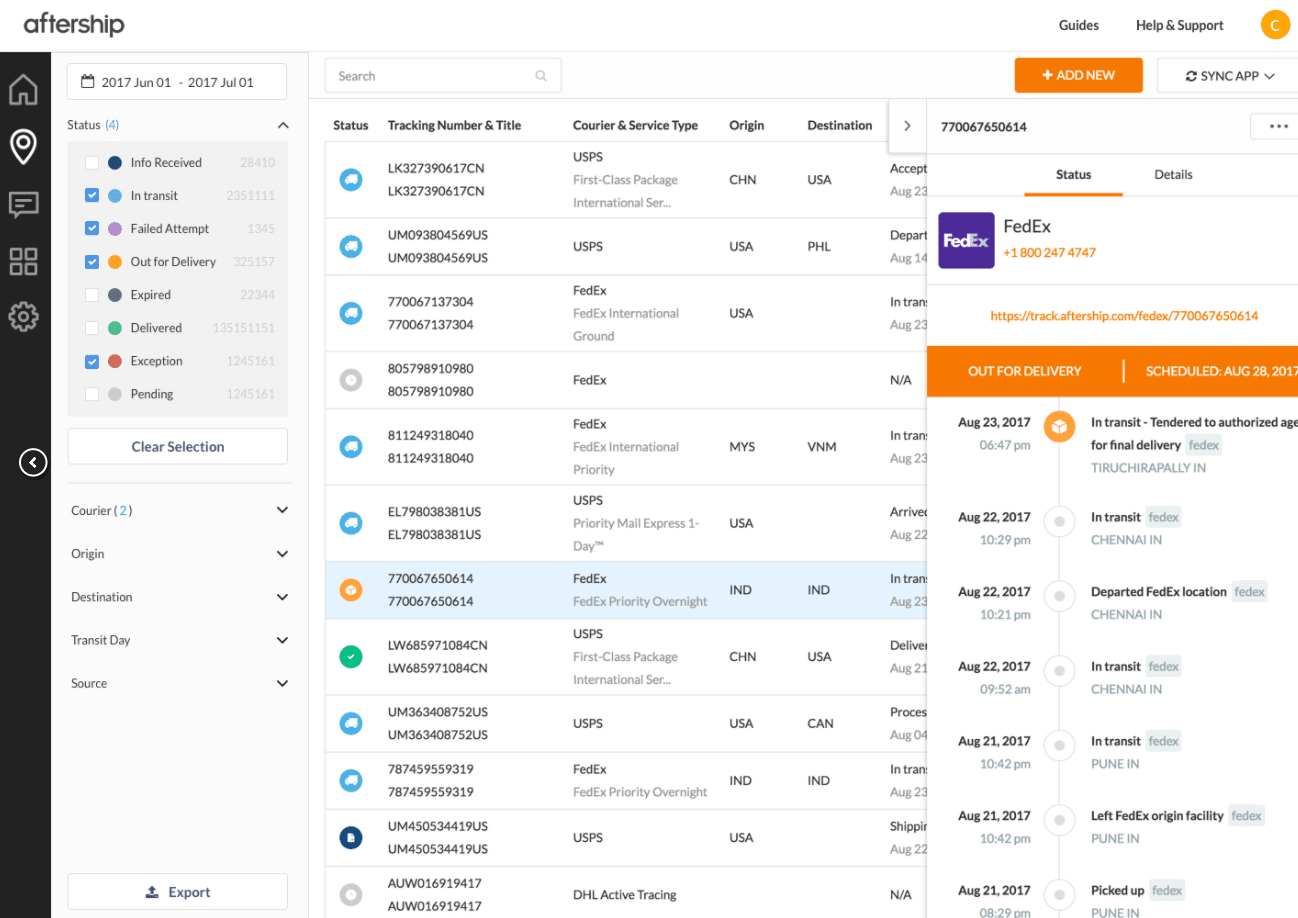


You can see direct tracking numbers and all of the tracking histories from your carrier.
On the home section of your dashboard, you can see tracking data for all of your shipments to see how performance changes over time:



If you miss deliveries or have failed ones, you’ve got plenty of actionable data to help you make carrier changes.
One of the best parts is that they allow you to create automated email campaigns, giving each new customer their tracking data:
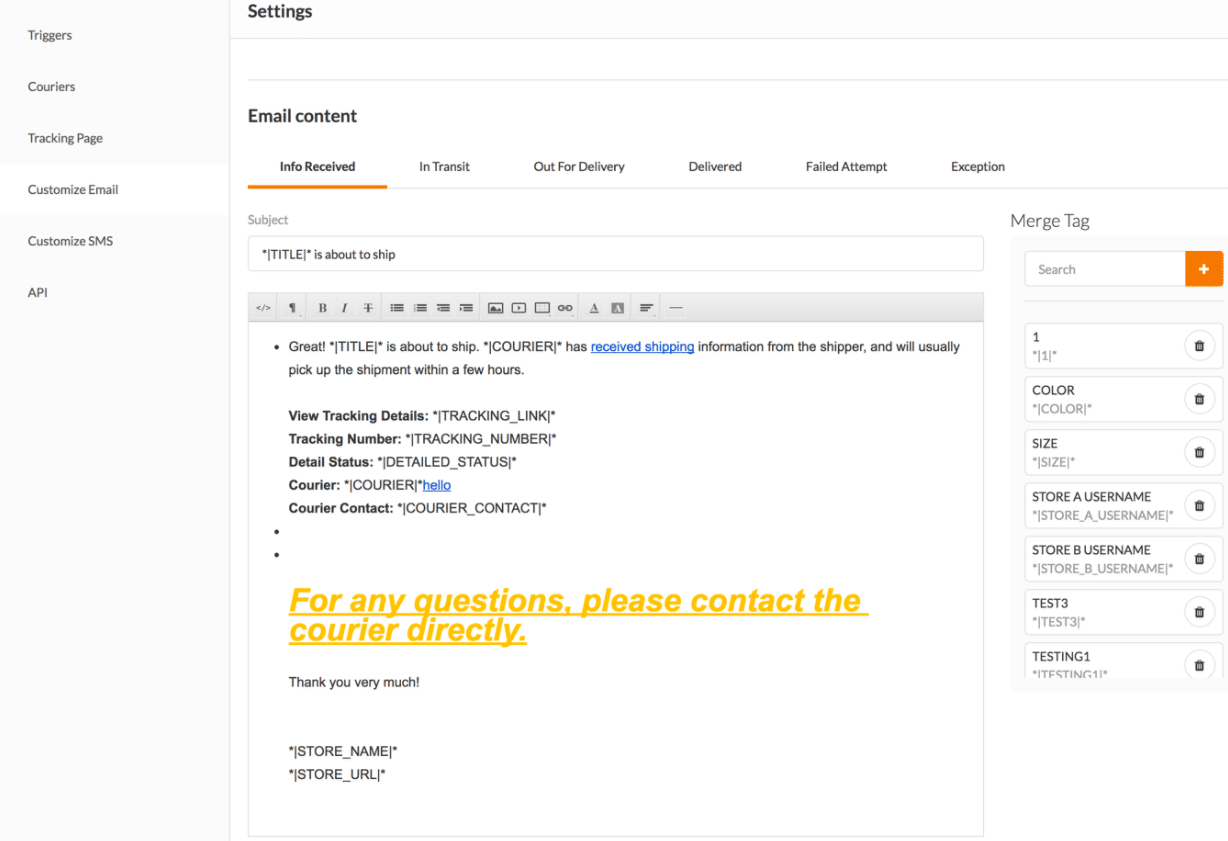


Meaning you can streamline the process for the consumer so that they always have access to their tracking data too.
Selling on an international level doesn’t have to cost you thousands.
Try using FedEx (or other carriers) and diverse tracking plugins on Shopify to get your international selling strategy off the ground and running.
Amazon isn’t the only place to sell internationally. You can give it a shot on your own website today.
Conclusion
Scaling your ecommerce business to multiple countries worldwide is tough.
You’ve got to be ready for shipping, delivery, patent issues, and more.
Complications can arise fast, but the rewards can be huge.
Tapping into new markets means new sources of income, traffic, and profit for your business.
And with the help of online marketplaces, crowdfunding sources, and diverse market research, it’s possible.
And thanks to Gaston from Hickies, we know that any small business is capable of doing it.
Follow these steps that we’ve laid out from Gaston’s plan, and you’ll be on your way to scaling your product to 50 countries worldwide.
What are some of the best ways you’ve seen companies sell internationally?
How have you taken an ecommerce business to new countries?

Comments